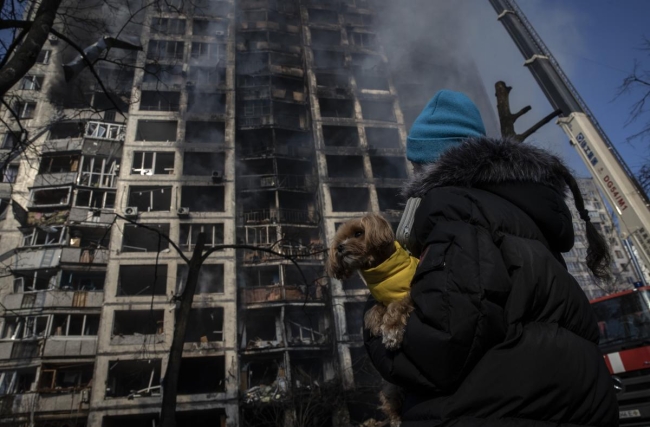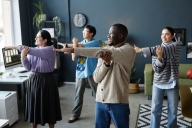You have /5 articles left.
Sign up for a free account or log in.

A woman with her dog outside a damaged residential building hit by a Russian attack in Kyiv, Ukraine.
Anadolu Agency/Getty Images
In college classrooms across the country, faculty members are teaching while the world is watching the Ukrainian-Russian conflict unfold. Professors are navigating student responses to this historical event that range from shock, dismay, outrage and fear to deep sadness, while simultaneously managing their own internal emotional landscapes. Classrooms offer the opportunity to have difficult conversations in turbulent times. But those conversations can be hard—really hard. The good news is that there are simple tools to guide us as we hold up the power of the classroom as the best place for the exchange of ideas.
I once had the opportunity in a gender studies course to teach Christine Blasey Ford’s testimony during Brett Kavanaugh’s Supreme Court nomination hearing. My class time overlapped exactly with Blasey Ford’s opening statement. There we were, 10 a.m., in the dark, as she prepared to share her experience of sexual assault in front of the Senate Judiciary Committee. Having taught challenging subject matter related to diversity, equity and inclusion and gender/race studies for 25 years, I confidently framed the hearings and anticipated the “triggers.” “We are watching history live,” I argued. Exuberantly, I claimed, “The classroom is ground zero for watching these hearings and grappling with them!”
So we began. At first, Blasey Ford started with a calm, measured opening as she led up to recounting her sexual assault. All seemed fine. Then, as Blasey Ford’s narrative became more graphic and as her distress as an assault survivor who felt disbelieved and discounted became more apparent, the students, too, responded to her story and her emotion. She cried, and they cried with her. The room was full of weeping. As I looked around, students were anguished. I had underestimated their response. Did I make a mistake? Had I done something horribly wrong? Did I prepare them properly? My anxiety grew. Should I end the hearing early? Should I turn off the TV? Should I just stop?
Inwardly, I tried to slow my breathing, managing frantic thoughts while desperately wanting to make the “right” judgment call. Outwardly, I appeared calm. I let the hearing roll on. As we neared the end of class, I asked everyone to make a circle. At a minimum, I wanted to close effectively. Even if I said little to nothing, I could provide space for them to depart a bit more intact. I said, “Can we all just take a deep breath?” I purposefully looked around slowly into their expectant faces. Then I paused and said, “I want to acknowledge how hard that was. You all were witness to something truly powerful. It may have stirred feelings and experiences in you as well. Can we go around and have everyone say a word about where they are right now? You can say pass, if you need.” It was hard for students to utter even one word.
Many students stayed after class, begging to talk. They shared painful stories of sexual harassment and violence, stories they had not previously disclosed. It was heavy. But they were also grateful. Grateful that they could be present for something so profound and grateful that they could choose how to respond to the epidemic of sexual violence. Blasey Ford named experiences that they, too, had encountered but did not have language for. One of the students has gone on to make responding to gender discrimination and violence her life’s work in her community. That day changed all of us; it also changed me as a teacher. Here are some things I’ve learned managing hard conversations, whether they happen inside the classroom or beyond.
Have Courage
From the French and Latin, to be of heart, to have heart. An undergraduate mentor of mine used to say, “The classroom is the riskiest place, because it needs to be the safest place.” We know that safety is relative; still, classrooms provide a way to practice risk.
Jay W. Roberts in Risky Teaching: Harnessing the Power of Uncertainty in Higher Education (Routledge) suggests that there is a cost to “playing it safe,” which can lead to a “learning experience that is passive, inauthentic, and disengaging.”
Educational theorist and Quaker Parker J. Palmer, in To Know as We Are Known: Education as a Spiritual Journey (HarperOne), notes that “teachers, too, enter the classroom with fears.” He writes, “Creating a learning space that is not closed down by fearful emotions requires a teacher who is not afraid of feelings.”
Have courage that you are doing the right thing even—and especially—when you are afraid.
Create the Space
What do you hope people will feel and think at the end of class? We know that form follows function and vice versa, but how many times have we entered a difficult conversation without factoring in the role of space? Will your classroom space and setup make the problem more or less difficult to solve? Make the space support your goals. Should the conversation happen in the classroom at all or in a different setting? Circle, horseshoe or group stations? Music? Lighting? Props? Food? I once taught in a classroom with a kitchen—what a blessed place. If only every classroom could have one! Architect John Cary argues that we can design spaces that grant people dignity and promote justice. Refer to his book Design for Good: A New Era of Architecture for Everyone (Island Press) for inspiration on how space creates the communities we want to inhabit.
Frame the Conversation
Begin the conversation with a frame. A frame is a map. It can be a simple four steps: 1) here is what I hope we can accomplish today; 2) here is how we want to treat one another; 3) here is the shape of our time; 4) this is how we will close. The Frameworks Institute is a think tank studying effective communication research on policy issues like equity, gun violence and health care. It offers powerful and productive frames for holding intractable conversations. One example the institute proposes: “Begin with a carefully chosen point of commonality—a shared value—that not only helps you connect, but opens people’s thinking to the new perspective you bring.” Starting the conversation with a few sentences on shared values is a frame that reminds people that they are interconnected, even when they disagree.
Establish Ground Rules
Stating ground rules gives students boundaries and parameters for difficult conversations. The good news is you do not have to create them. The class can create them together and quickly. You can say, “Take three minutes in small groups and make a list.”
Other prompts to help students generate ground rules would include, “You know you are in a good conversation when …” or, its opposite, “You know you are in a bad conversation or flailing argument when …” Sometimes students can more readily identify the opposite of productive conversation. What were the qualities of that failed exchange and what can we learn to avoid?
Neuroscientist David Rock developed the SCARF model, a science-based approach establishing what people need to remain present in the conversation: status, certainty, autonomy, relatedness (or a sense of belonging) and fairness. Introducing the SCARF model is another way to approach a difficult conversation with an evidence-based frame.
Ground rules can also refer to ideas about psychological safety; “safe space” versus “brave space” frames are useful, as the National Association of Student Personnel Administrators helpfully defines the terms.
Hold the Space
Facilitating “productive discomfort” and creating a “pedagogy of discomfort” is the goal as Kathryn C. Oleson describes it in Promoting Inclusive Classroom Dynamics in Higher Education: A Research-Based Pedagogical Guide for Faculty (Stylus). Drawing on the scholarship of educational researchers Michalinos Zembylas and Claire McGlynn, Oleson recommends faculty members consider a series of questions when preparing to lead a difficult conversation on charged topics: a) the “appropriateness of creating discomfort”; b) the “impact of discomfort”; and c) the “ethical implications of a pedagogy of discomfort.” If you are clear about your answers to these three questions, then proceed with assurance.
Additionally, preparing yourself with classics in the field of conflict resolution bolsters confidence. Anything from the Harvard Negotiation Project is golden, including the canonical Difficult Conversations: How to Discuss What Matters Most. Another helpful text is Crucial Accountability: Tools for Resolving Violated Expectations, Broken Commitments, and Bad Behavior (McGraw Hill).
Keep Tools in the Toolbox
Always have a backup plan. For example, if the conversation becomes divided and conflict-filled, consider pausing for students to journal or do a deep-listening exercise. I began incorporating deep-listening exercises in classes after observing students increasingly shut down judgmentally about experiences and identities that they watched in a video or read about briefly but did not comprehend. A deep-listening exercise can be as simple as, “take three minutes to listen to your partner finish this prompt, reflect back what you heard, switch partners and discuss the conversation.” Daniel P. Barbezat and Mirabai Bush’s book, Contemplative Practices in Higher Education: Powerful Methods to Transform Teaching and Learning (Wiley) has such practical examples. Relatedly, the Association for Contemplative Mind in Higher Education has terrific resources that deepen conversation peacefully.
Finally, the late Buddhist monk Thich Nhat Hanh, in The Art of Communicating (HarperOne) demonstrates how to cultivate “mindful” and “compassionate communication,” which is an essential skill to teach students for life and not just the classroom.
Close Well
Close the conversation with intention. This can be as basic as having everyone write one sentence on their takeaway on an index card (or tweet/chat), having students go around the room with a one-word takeaway, or asking students to turn to a partner and share closing thoughts. You can read a quotation or even, more boldly, have a moment of silence.
Facing History is a wonderful pedagogical nonprofit that creates resources for teaching difficult historical subjects especially around issues of inequity and systemic oppression; here is its list of opening and closing rituals after challenging discussions.
Classrooms can model democracy. In a classroom, we solve conflict through talking, thinking and debating rather than through violence. Classrooms are a place where we can learn to talk rather than learn to fight. As bell hooks says in Teaching to Transgress (Taylor & Francis), “The classroom is a location of possibility.”
As a caveat to these guidelines, remember that sometimes things fall apart in difficult conversations. Even with these steps and our best intentions, the conversation can go sideways. That’s OK: if it happens, you learned something and you can now try it again.
Another caveat—these practices can be harder when, because of one’s identity, the classroom is already a space challenging your power as a woman, BIPOC and/or queer faculty member. Standpoint and location are critical to acknowledge when tackling hard conversations. Finding co-conspirators and also administrative support (provost, deans, chairs) when engaging in difficult or risky subject matter is crucial. Leaning in to your faculty-development office is another critical resource.
In the end, expanding our capacity to create authentic and powerful educational spaces is part of higher education’s fundamental mission. It is our call to teach into conflict.








